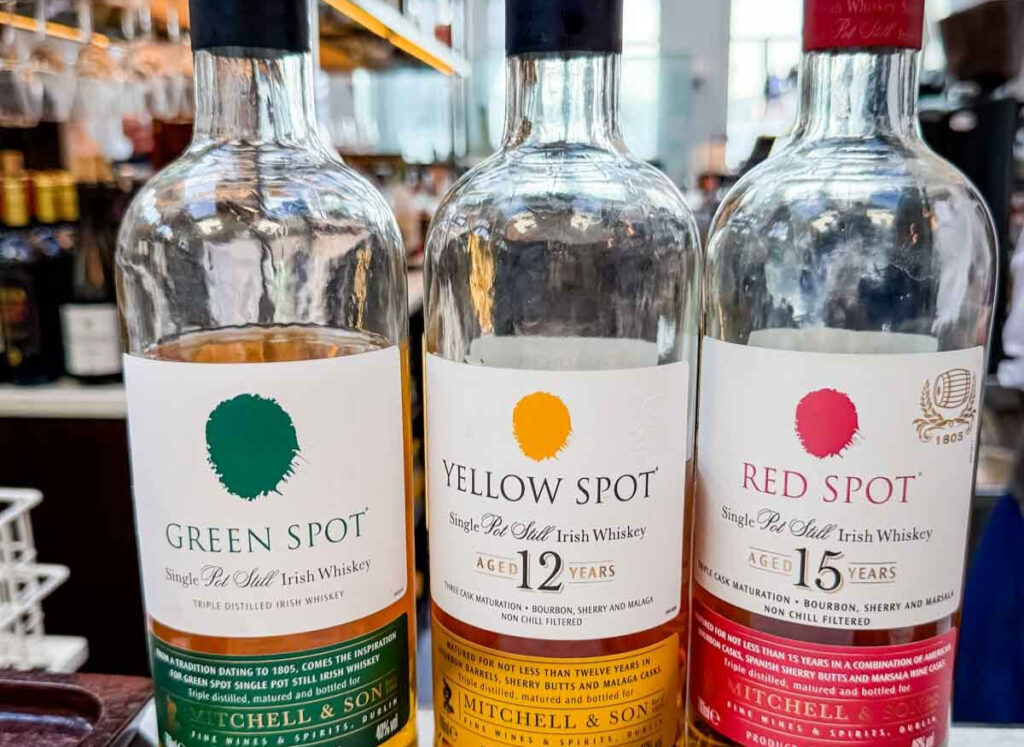Irish whiskey exports jumped by 13% in 2024, and the global market is expected to hit $9.5 billion by 2033. The resurgence is powered by a mix of heritage brands and experimental newcomers crafting everything from peated blends to single pot still innovations. This momentum illustrates why Irish whiskey is surging in popularity, and distillers are racing to keep up, working to meet global demand while reimagining the spirit for a new generation of drinkers.

Across Ireland, historic and modern distilleries are redefining what Irish whiskey can be, with long-established producers doubling down on authenticity, aging whiskey in rare casks and reviving century-old recipes. This creative tension between legacy and innovation is reshaping the category into one of the most dynamic in the spirits world.
The global surge of Irish whiskey
The world’s growing thirst for Irish whiskey marks a seismic shift, signaling a deeper transformation in how global consumers perceive and enjoy the spirit. In 2024, the market reached $5.4 billion, reflecting the success of heritage brands and the momentum of a modern revival more than a decade in the making. This milestone doesn’t just mark financial growth; it underscores how Irish whiskey has carved out a distinct identity in the crowded global spirits market, blending history, flavor and cultural appeal into every bottle.
Younger drinkers, especially Gen Z, are a significant part of the surge. They are reshaping whiskey culture by embracing it in cocktails and mixed drinks rather than traditional neat pours. Even as this generation drinks less alcohol overall than those before them, they gravitate toward spirits like Irish whiskey over beer and wine, carving a space for it in casual and social settings.
“I’m really encouraged by the Gen Z predisposition to the cocktail culture,” says Conor McQuaid, chairman and CEO of Jameson maker Pernod Ricard, in Fast Company. He also notes that the future looks bright as this new wave of whiskey drinkers comes of age, bringing with them a more adventurous palate, a curiosity for new experiences and a willingness to redefine how and where whiskey fits into modern life.
Distilleries worth knowing
Ireland’s distillery scene is experiencing its fastest growth in decades, with dozens of new producers entering the market since 2010. From urban micro-distilleries to rural estates with centuries of legacy, these distilleries redefine what Irish whiskey means in a global market.
Muff Liquor Company
Laura Bonner and Tom Russell founded The Muff Liquor Company in 2017 to honor Bonner’s grandfather Philip McClenaghan, a Donegal potato farmer whose poitin-making legacy blended tradition and mischief. That legacy now lives on in their peated Irish whiskey, a bold small-batch blend featuring five distinct Irish malt and grain components. A mix of virgin oak-matured and bourbon cask-matured grain whiskey, alongside sherry-aged, double-distilled and triple-distilled peated malt, provides a smooth, layered profile that reflects Donegal’s earthy, clean and quietly rebellious spirit.
While the brand is also known for its gin and vodka, its whiskey is increasingly gaining attention for its depth and subtle peat smoke. With a distilling approach rooted in family tradition and modern refinement, Muff’s whiskey offers a creative twist on Irish standards. It’s a rising name for drinkers looking beyond the big brands.
Titanic Distillers
Tucked into Belfast’s historic Thompson Dock, Titanic Distillers is the first working distillery in the city’s docklands in almost 90 years. Shipbuilders once constructed the RMS Titanic on this very site, and today, the distillery embraces the location with immersive visitor experiences that combine the legacy of shipbuilding with the craft of whiskey making. Guided tours through the original pumphouse and dry dock offer a rare look at industrial history alongside modern distillation.
Inside, the facility uses traditional copper pot stills and small-batch production methods that reflect the grit and pride of Belfast. Distillation began on-site in 2023, and future house-made releases are in the works. Every detail, from the branding to the sensory experience, tells the story of a city reclaiming its whiskey heritage with authenticity and ambition. This is an exceptional whiskey for classics like an old fashioned cocktail.
Spot Whiskey
Spot Whiskey is a historic range of single pot still Irish whiskeys, which are made at Midleton Distillery in County Cork for Mitchell & Son, a Dublin wine and spirits merchant in the 1800s. They built their whiskey reputation by aging spirit in fortified wine casks under Fitzwilliam Lane, which is an approach that defined their signature style. That same process shapes today’s Spot range, which still honors its origins with careful small-batch production.
The lineup includes Green Spot, Yellow Spot, Blue Spot and Red Spot, each named for the color-coded marks once used to track cask age and style. Green Spot matures in a combination of ex-bourbon and ex-sherry casks for seven to 10 years, while Yellow Spot adds ex-Malaga casks and ages for a full 12-year period. The distillers finish the limited edition Green Spot Château Léoville Barton in Bordeaux wine barrels, resulting in unique flavor profiles that celebrate the bonders’ craft.
Powerscourt Distillery
Set within the grounds of one of Ireland’s grandest estates, Powerscourt Distillery fuses architectural elegance with modern whiskey science. Its world-class facility, designed by Forsyths of Scotland, allows for triple and double distillation using copper pot stills.
Visitors walk through the live production floor, where they can witness whiskey making up close before heading to the Whiskey Lounge for a Fercullen tasting. Along the way, they’ll see copper pot stills in action and gain insight into the scale of daily operations. At full capacity, the distillery has the potential to produce 280,000 liters of alcohol annually, enough to fill 40 barrels a day or distill over 3 million bottles of whiskey each year.
Dingle Distillery
The Dingle Whiskey Distillery was founded in 2012 by three trailblazers, Oliver Hughes, Liam LaHart and Peter Mosley, who had already made waves in Ireland’s craft beer scene with the Porterhouse Brewing Company. Frustrated by the dominance of large brands and inspired by a love for bold flavors, they envisioned an artisan distillery that could stand apart. That vision took shape during a cold Kerry winter, when they quietly filled the first whiskey casks in December 2012.
Launched as one of the first distilleries to spark Ireland’s modern craft whiskey revival, Dingle quickly became known for its limited-edition single malts and collector-loved small batches. Visitors to the coastal town can tour the working distillery, see its three copper pot stills in action and experience its boutique scale firsthand. From its Founding Fathers program to its smooth, flavorful spirits, Dingle continues to lead the new wave of Irish whiskey makers with a bold, independent voice.
Iconic brands still leading
Legacy brands are maintaining a stronghold in the market by balancing consistency with inventive new releases that reflect modern tastes. Their influence runs deep, making them essential players in the story of Irish whiskey’s global resurgence.
Jameson
Jameson remains the world’s best-selling Irish whiskey, thanks to its triple-distilled smoothness and consistent flavor. Midleton Distillery in Cork produces it entirely on-site, carefully managing every step from grain to glass. Visitors can tour the distillery to see how production and aging come together, part of a process that has driven decades of growth.
The brand uses casks from the United States and Spain, once home to bourbon and fortified wine, which lend vanilla, toasted wood and sherry notes to the whiskey. These casks age for at least three years in Ireland, often at distilleries like Midleton, where about 2% evaporates annually in what’s called the Angel’s Share. That aging process, along with in-house blending by Head Blender Billy Leighton, shapes Jameson’s smooth flavor and consistent character.
Tullamore D.E.W.
Tullamore D.E.W. is one of the few distilleries in Ireland that blends all three types of Irish whiskey, such as grain, malt and pot still, for a signature depth and complexity. Its modern facility in Tullamore produces the original triple-distilled, triple-cask-finished, triple-blended Irish whiskey, which now ranks as the second-best-selling Irish whiskey in the world. The Visitor Centre, set in a former bonded warehouse, invites guests to explore the brand’s deep roots in a small but proud Irish town where distilling began in 1829.
This strong community identity is central to the brand. In Tullamore, where everyone knows each other, people value authenticity over image, and that spirit carries into every bottle. The brand chose the Irish wolfhound over a traditional crest to reflect loyalty, boldness and drive, which are traits that founder Daniel E. Williams and his family passed down through generations.
Teeling
Whiskey-making has been in the Teeling family since 1782, when Walter Teeling opened a craft distillery in Dublin’s Marrowbone Lane. In 2015, brothers Jack and Stephen Teeling came full circle, opening the first new distillery in Dublin in over 125 years, just down the road from their ancestors’ original site. Built in the Liberties, Dublin’s historic distilling district, the modern facility is open to the public and celebrates both tradition and innovation.
Teeling’s whiskeys are known for breaking convention, combining traditional craft with experimental techniques. They use atypical mash bills, unique cask finishes and a 46% ABV bottling strength to retain full flavor without chill filtration. Every bottle reflects their commitment to bold, forward-thinking distilling, embodying the spirit of Dublin’s past and future.
The final pour
Irish whiskey is rewriting the playbook on global spirits, gaining ground in volume and prestige. Established giants and daring newcomers are scaling operations, expanding exports and reshaping how the world sees and sips Ireland’s signature drink. With demand climbing and innovation accelerating, the country is no longer catching up; it’s setting the pace. The next chapter in Irish whiskey’s story is now about global leadership in a fiercely competitive spirits market.
Jennifer Allen is a retired professional chef and long-time writer. Her work appears in dozens of publications, including MSN, Yahoo, The Washington Post and The Seattle Times. These days, she’s busy in the kitchen developing recipes and traveling the world, and you can find all her best creations at Cook What You Love.
The post Irish whiskey is surging in popularity, and distillers are racing to keep up appeared first on Food Drink Life.













(0) comments
Welcome to the discussion.
Log In
Keep it Clean. Please avoid obscene, vulgar, lewd, racist or sexually-oriented language.
PLEASE TURN OFF YOUR CAPS LOCK.
Don't Threaten. Threats of harming another person will not be tolerated.
Be Truthful. Don't knowingly lie about anyone or anything.
Be Nice. No racism, sexism or any sort of -ism that is degrading to another person.
Be Proactive. Use the 'Report' link on each comment to let us know of abusive posts.
Share with Us. We'd love to hear eyewitness accounts, the history behind an article.